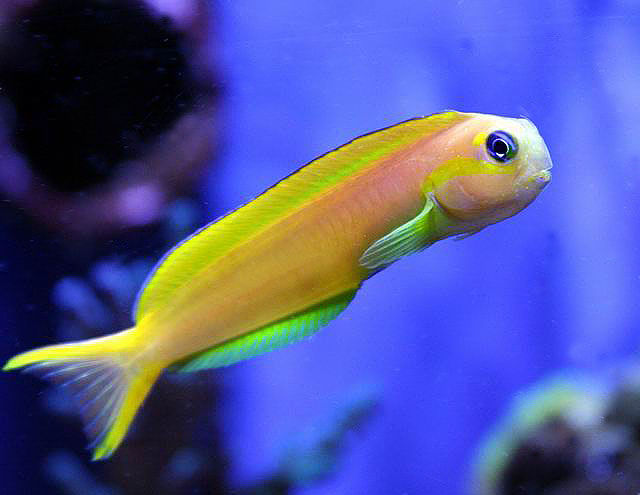
Midas Blenny Care Guide
Glossary:
- Care Guide & Requirements
- Reef Safe
- Prices
- Food & Diet
- Facts
- FAQs
- Tank Mates & Environment
The Midas Blenny, or Ecsenius midas, is a great fish to start with when adding fish to a saltwater tank. This uniquely golden-colored fish can add an aesthetic touch to your tank while remaining one of the easier fish to care for, with relatively minimal maintenance.
The following guide will review what you need to do to keep this fish and what to expect before buying one or more Midas Blennies.
Is the Midas Blenny reef safe?
The Midas Blenny is reef safe if you take the right precautions. It often varies from fish to fish. While some might completely ignore the coral, other fish might nip at it to the point where they kill it.
The best way to gauge the fish’s aggressiveness toward coral is to observe it for a period after putting it in with a piece of coral. If it appears to be attacking the coral, it might be best to avoid keeping it in a tank with coral, in which case you may be able to transfer your corals to another tank.
Midas Blenny food and diet
Midas Blennies tend to eat many types of natural foods. Some potential foods could include Mysis shrimp, spinach, marine algae, Spirulina, krill, tunicate and sponge colonies, and angelfish preparations.
If you experience difficulty feeding the Midas Blenny, try to introduce gut-loaded brine shrimp to the tank, which may inspire the fish’s appetite.
Midas Blenny facts
Here are some interesting facts about the Midas Blenny that might surprise you:
- You can find the Midas Blenny along the coasts of Australia, South Africa, Asia, and the U.S.
- Their current conservation status is of “Least Concern,” meaning their populations aren’t facing extinction at this time.
- Midas Blennies can grow up to four to five inches in length.
What other fish are the best tank mates for the Midas Blenny?
The Midas Blenny is reef-safe, meaning that you can safely keep this fish with all types of coral, including large stony polyp (LPS) and small stony polyp (SPS) corals, along with anemones. They are also compatible with many types of other fish and invertebrates, but you should try to keep this Blenny separate from other Blennies. Additionally, keep this fish away from other planktivores.
Some compatible tank mates to consider include:
- Tangs
- Cardinalfish
- Boxfish
- Angelfish
- Grunts
- Goatfish
- Puffers
- Butterflyfish
- Anthias
- Hawkfish
- Filefish
- Squirrelfish
- Damselfish
- Clownfish
However, keep in mind that the Midas Blenny might become aggressive if there are too many fish in your tank. To avoid any issues, don’t overcrowd your tank with fish and ensure the Midas Blenny has plenty of territory to claim as its own.
Midas Blenny price
Midas Blennies aren’t the most expensive fish to get, though they are slightly more expensive than other types of Blennies. You can find Midas Blennies at a price that’s relatively affordable, with costs ranging from around $60 to $100 in most cases, but you might find some on the higher end at about $150.
Midas Blenny FAQs
How long do Midas Blennies live?
The Midas Blenny can live for around two to five years with proper care. As such, this species may not be the best if you want a fish that’s likely to live longer.
Can you keep multiple Midas Blennies?
While it’s possible to keep multiple Blennies in the same tank, you’re better off keeping only one at a time unless you have a male and female. One potentially viable combination is a Midas Blenny and a Scooter Blenny, the latter of which isn’t technically a Blenny.
Does the Midas Blenny change color?
Midas Blennies can change color, but only if they get scared. If you find your Midas Blenny changing colors, this could indicate that the fish is in an incompatible and perceivably unsafe environment or that your tank is too small.
Where to buy Midas Blennies
You can buy Midas Blennies from the following online stores, among others:
